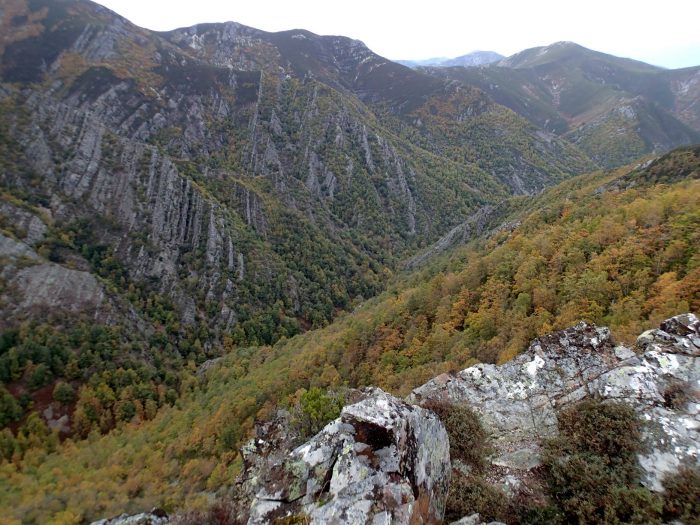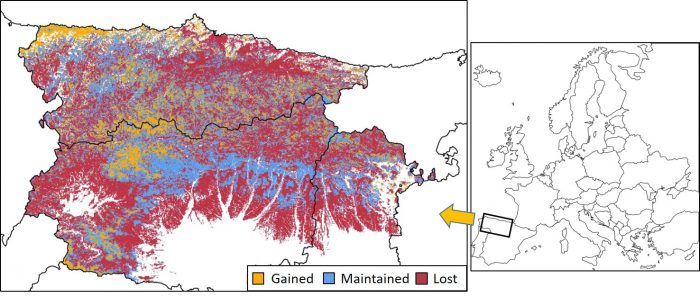
Brown bears, like many other large carnivores, are recovering and expanding their range in recent years, especially in Europe. In order to enable their coexistence with humans, new strategies are crucial to ensure their survival, such as identifying areas they could potentially inhabit, exploring their behavior, or delving into possible future changes to their environment.
Some studies of brown bears in human-modified landscapes have been recently developed by a research group located in the north of Spain (Research Unit of Biodiversity, UMIB), focusing on the small, isolated, and endangered population of Cantabrian brown bears. This expanding population hosts about 300 individuals and is divided into two slightly connected subpopulations.
First, the researchers explored the brown bears’ habitat use and selection, and found potentially favorable habitats for these brown bears using maximum entropy models. Including distribution data and different landscape variables (altitude, slope, vegetation, human infrastructures…), MaxEnt software provided variables that defined bear presence and a probability of occurrence for the area of study. This probability is based mainly on how similar the area is to where bears actually live.

Image by Vincenzo Penteriani, published with permission
Cantabrian bears usually prefer steep mountain areas with low human population density and great forest cover, although they can adapt to many situations. This study reflects that there are still many suitable areas for the presence of bears available where the smallest subpopulation is located, while for the other subpopulation, almost all suitable habitat is already occupied by the species (although the density of individuals it is not yet optimal). Identifying a priori these areas of expansion can avoid many conflicts with the humans who inhabit these places since damage prevention measures and information campaigns can be established to make the imminent coexistence of these people and brown bears easier.
As Cantabrian brown bears are mostly vegetarian, changes and reductions of the plants they feed on and that offer them refuge can be decisive to the future of this species. The group studied future changes in the distribution of several trees that serve as food or cover for bears (chestnut, oak, beech, holm oaks, and blueberries) due to climate change. They included a big compilation of environmental variables (climate, hydrography, population, roads, soil…) in the present and in the future (2050 and 2070 in two climate change scenarios: moderate and pessimistic) and the occurrence of data for each tree species using the machine learning algorithm Random Forest. Later, each tree species’ model was used as an individual predictor for the bear’s potential distribution in the different scenarios.
The results show a reduction in almost all the tree species distribution in future climate change scenarios, and some of them might shift toward areas with lower altitude further north, where human density is higher. Therefore, bears would have to move to territories where they can find food and shelter, approaching, in turn, highly-populated areas. Exploring these changes provides a new vision for the conservation of threatened species in the long-term, allowing the development of strategies with greater anticipation than usual.

The habitat change for all the trees of the study in the pessimistic scenario in 2070. Credit: Alejandra Zarzo
The Cantabrian Mountains are, in general, a quite humanized area, although most of the villages in the bear territory are small. Moreover, the road network and the presence of human activities such as cattle raising or agriculture leave little homogeneous space for bears. The Cantabrian brown bear research group studied the effect of different structures and human activities’ distance (villages, roads, nature observation points…) on bears’ behavior, analyzing alert behavior of 80 hours of recorded bears over a 10-year period with the software BORIS.
The results obtained suggest that the general pattern of human avoidance by bears is adapted to the human-modified landscape they inhabit, and the proximity of infrastructures or human activities does not seem to trigger an increase in their alert behavior. But there might be more subtle effects (such as physiological stress) that could be acting on individuals without showing obvious repercussions on their behavior.
To improve conservation measures, more research is needed, including techniques such as telemetry of the individuals to know more precisely where and when bears move, as well as their rhythms of activity.
These findings are described in the articles entitled Identifying potential areas of expansion for the endangered brown bear (Ursus arctos) population in the Cantabrian Mountains (NW Spain), recently published in the journal PLOS One, as well as Responses of an endangered brown bear population to climate change based on predictable food resource and shelter alterations, recently published in the journal Global Change Biology, and Brown bear behaviour in human-modified landscapes: The case of the endangered Cantabrian population, NW Spain, recently published in the journal Global Ecology and Conservation.









